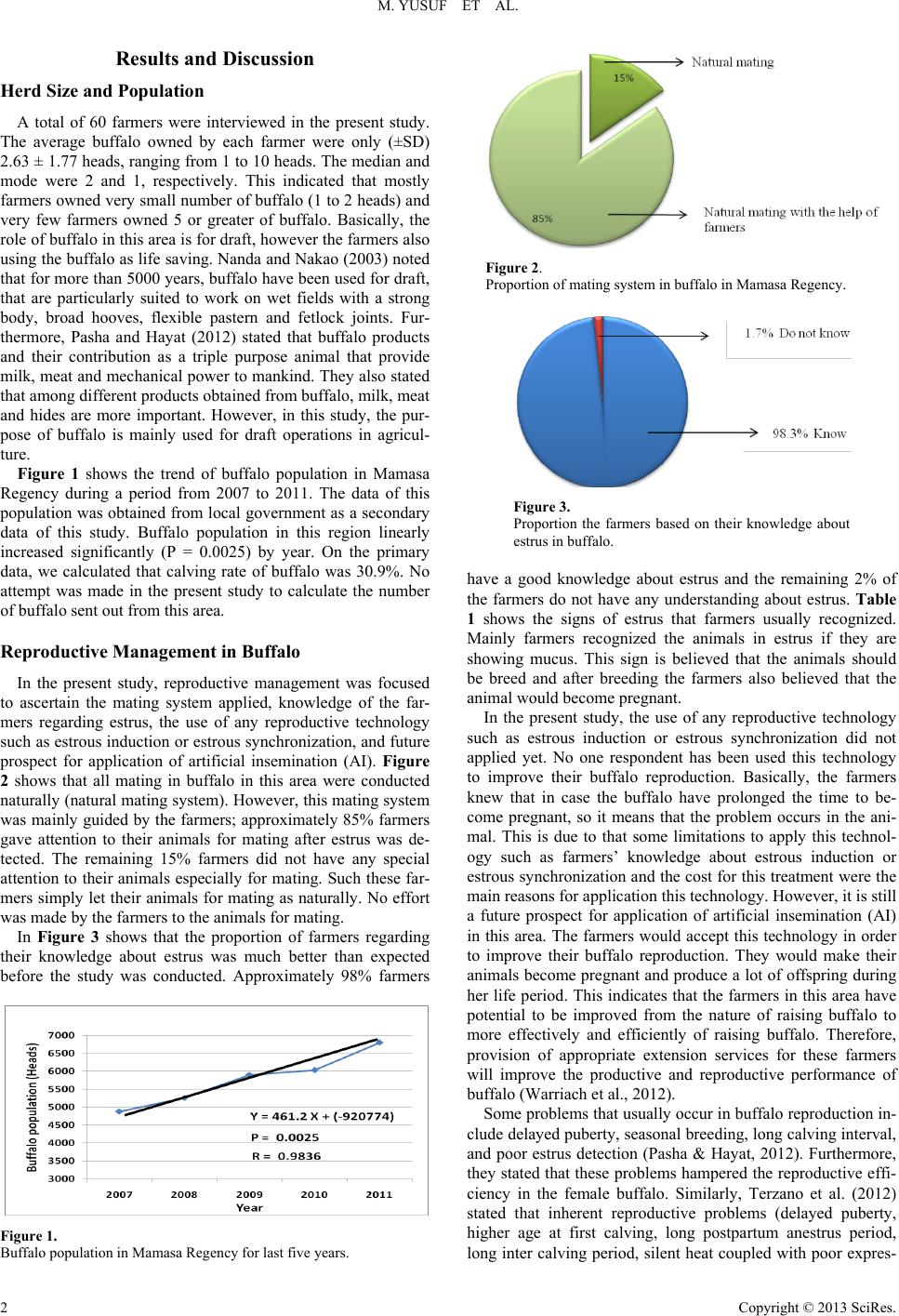
M. YUSUF ET AL.
Copyright © 2013 SciRes.
Results and Discu ssion
Herd Size and Population
A total of 60 farmers were interviewed in the present study.
The average buffalo owned by each farmer were only (±SD)
2.63 ± 1.77 heads, ranging from 1 to 10 heads. The median and
mode were 2 and 1, respectively. This indicated that mostly
farmers owned very small number of buffalo (1 to 2 heads) and
very few farmers owned 5 or greater of buffalo. Basically, the
role of buffalo in this area is for draft, however the farmers also
using the buffalo as life saving. Nanda and Nakao (2003) noted
that for more than 5000 years, buffalo have been used for draft,
that are particularly suited to work on wet fields with a strong
body, broad hooves, flexible pastern and fetlock joints. Fur-
thermore, Pasha and Hayat (2012) stated that buffalo products
and their contribution as a triple purpose animal that provide
milk, meat and mechanical power to mankind. They also stated
that among different products obtained from buffalo, milk, meat
and hides are more important. However, in this study, the pur-
pose of buffalo is mainly used for draft operations in agricul-
ture.
Figure 1 shows the trend of buffalo population in Mamasa
Regency during a period from 2007 to 2011. The data of this
population was obtained from local government as a secondary
data of this study. Buffalo population in this region linearly
increased significantly (P = 0.0025) by year. On the primary
data, we calculated that calving rate of buffalo was 30.9%. No
attempt was made in the present study to calculate the number
of buffalo sent out from this area.
Reproductive Management in Buffalo
In the present study, reproductive management was focused
to ascertain the mating system applied, knowledge of the far-
mers regarding estrus, the use of any reproductive technology
such as estrous induction or estrous synchronization, and future
prospect for application of artificial insemination (AI). Figure
2 shows that all mating in buffalo in this area were conducted
naturally (natural mating system). However, this mating system
was mainly guided by the farmers; approximately 85% farmers
gave attention to their animals for mating after estrus was de-
tected. The remaining 15% farmers did not have any special
attention to their animals especially for mating. Such these far-
mers simply let their animals for mating as naturally. No effort
was made by the farmers to the animals for mating.
In Figure 3 shows that the proportion of farmers regarding
their knowledge about estrus was much better than expected
before the study was conducted. Approximately 98% farmers
Figure 1.
Buffalo population in Mam asa Regency for last five years.
Figure 2.
Proportion of mating system in buffalo in Mamasa Regency.
Figure 3.
Proportion the farmers based on their knowledge about
estrus in buffalo.
have a good knowledge about estrus and the remaining 2% of
the farmers do not have any understanding about estrus. Table
1 shows the signs of estrus that farmers usually recognized.
Mainly farmers recognized the animals in estrus if they are
showing mucus. This sign is believed that the animals should
be breed and after breeding the farmers also believed that the
animal would become pregnant.
In the present study, the use of any reproductive technology
such as estrous induction or estrous synchronization did not
applied yet. No one respondent has been used this technology
to improve their buffalo reproduction. Basically, the farmers
knew that in case the buffalo have prolonged the time to be-
come pregnant, so it means that the problem occurs in the ani-
mal. This is due to that some limitations to apply this technol-
ogy such as farmers’ knowledge about estrous induction or
estrous synchronization and the cost for this treatment were the
main reasons for appl ication this technology. However, it is still
a future prospect for application of artificial insemination (AI)
in this area. The farmers would accept this technology in order
to improve their buffalo reproduction. They would make their
animals become pregnant and produce a lot of offspring during
her life period. This indicates that the farmers in this area have
potential to be improved from the nature of raising buffalo to
more effectively and efficiently of raising buffalo. Therefore,
provision of appropriate extension services for these farmers
will improve the productive and reproductive performance of
buffalo (Warriach et al., 2012).
Some problems that usually occur i n buffalo reproduction in-
clude delayed puberty, seasonal breeding, long calving interval,
and poor estrus detection (Pasha & Hayat, 2012). Furthermore,
they stated that these problems hampered the reproductive effi-
ciency in the female buffalo. Similarly, Terzano et al. (2012)
stated that inherent reproductive problems (delayed puberty,
higher age at first calving, long postpartum anestrus period,
long inter calving period, silent heat coupled with poor expres-